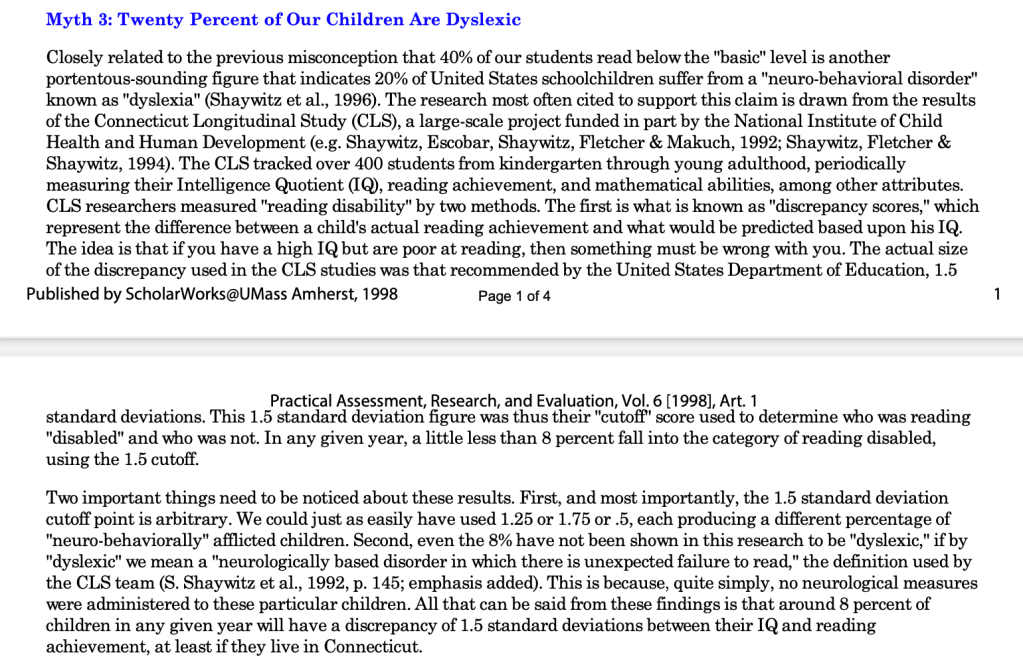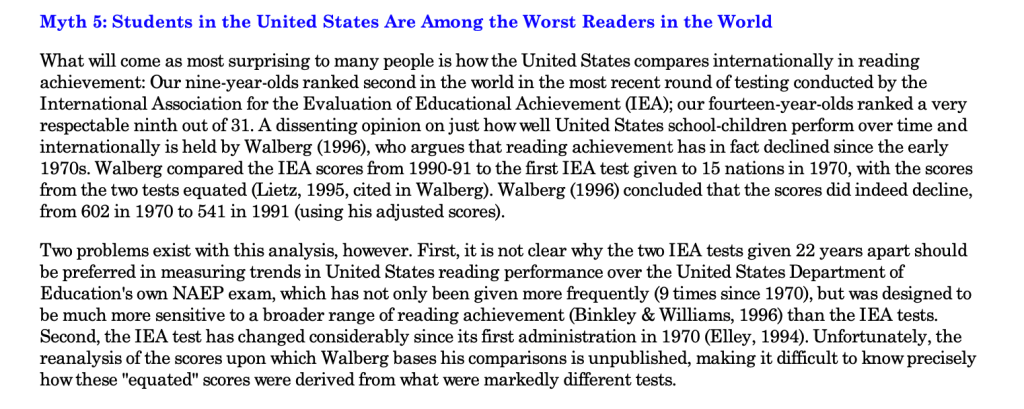[UPDATE]
After posting this in 2019 while working on the first edition of How to End the Reading War and Serve the Literacy Needs of All Students: A Primer for Parents, Policy Makers, and People Who Care, I have published the second edition and continued to work on the “science of reading” movement.
Regretfully, McQuillan’s work is even more relevant in 2023 because the media and political response to the SOR movement has gained momentum despite the evidence that it is mostly misinformation and another round of the exact reading war McQuillan debunked in the 1990s.
I highly recommend accessing this (which I will cite/quote below in the update of the original post):
McQuillan, Jeff (1998) “Seven Myths about Literacy in the United States,” Practical Assessment, Research, and Evaluation: Vol. 6 , Article 1.
DOI: https://doi.org/10.7275/em9c-0h59
Available at: https://scholarworks.umass.edu/pare/vol6/iss1/1 [1]
Recently, I have been (frantically but carefully) drafting a new book for IAP about the current “science of reading” version of the Reading War: How to End the Reading War and Serve the Literacy Needs of All Students: A Primer for Parents, Policy Makers, and People Who Care.
Those familiar with this blog and my scholarly work should be aware that I often ground my examinations of education in a historical context, drawing heavily on the subject of my dissertation, Lou LaBrant. The book I am writing begins in earnest, in fact, with “Chapter 1: A Historical Perspective of the Reading War: 1940s and 1990s Editions.”
As I have posted here, the “science of reading” over-reaction to reading and dyslexia across mainstream media as well as in state-level reading legislation has a number of disturbing parallels with the claims of a reading crisis in the 1980s and 1990s. Few people, I explained, are aware of the 1997 report authored by Linda Darling-Hammond on NAEP, reading achievement in the U.S., and the positive correlations with whole language (WL) practices and test scores.
I imagine even fewer education journalists and political leaders have read a powerful and important work about that literacy crisis in the 1990s, Literacy Crises: False Claims and Real Solutions by Jeff McQuillan.
In his Chapter 1, “What Isn’t Wrong with Reading: Seven Myths about Literacy in the United States,” McQuillan admits, “Serious problems exist with reading achievement in many United States schools,” adding, “Yet in the midst of media coverage of our (latest) ‘literary crisis,’ we should be very clear about what is and is not failing in our schools” (p. 1).
This leads to his list of myths ([1] updated with material from McQuillan’s article noted above), which are again being recycled in the “science of reading” version of the Reading War:
Myth 1: Reading Achievement in the United States Has Declined in the Past Twenty-Five Years.
Myth 2: Forty Percent of United States Children Can’t Read at a Basic Level.
Myth 3: Twenty Percent of Our Children Are Dyslexic.
Myth 4: Children from the Baby Boomer Generation Read Better than Students Today.
Myth 5: Students in the United States Are Among the Worst Readers in the World.
Myth 6: The Number of Good Readers Has Been Declining, While the Number of Poor Readers Has been Increasing.
Myth 7: California’s Test Scores Declined Dramatically Due to Whole Language Instruction.
DOI: https://doi.org/10.7275/em9c-0h59
McQuillan carefully dismantles each of these, with evidence, but many today continue to make the same misguided and unsupported claims.
In 2019 (and 2023), McQuillan’s work remains important, and relevant, both for understanding how we should teach better our students to read and how the current version of the Reading War is wandering once again down very worn dead-end roads.








